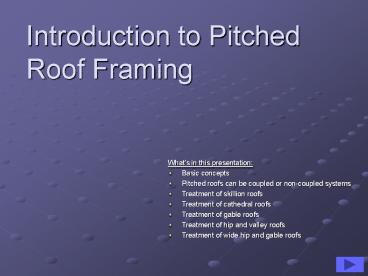Introduction to Pitched Roof Framing - PowerPoint PPT Presentation
1 / 10
Title:
Introduction to Pitched Roof Framing
Description:
Introduction to Pitched Roof Framing What s in this presentation: Basic concepts Pitched roofs can be coupled or non-coupled systems Treatment of skillion roofs – PowerPoint PPT presentation
Number of Views:877
Avg rating:3.0/5.0
Title: Introduction to Pitched Roof Framing
1
Introduction to Pitched Roof Framing
- Whats in this presentation
- Basic concepts
- Pitched roofs can be coupled or non-coupled
systems - Treatment of skillion roofs
- Treatment of cathedral roofs
- Treatment of gable roofs
- Treatment of hip and valley roofs
- Treatment of wide hip and gable roofs
2
Basic Concepts
- Pitched roofs rely on rafters to provide the main
skeleton of the frame - Distribution of roof loads is determined by
rafter spans, overhangs and rafter spacings - Ridge, intermediate and wall supports share the
load - Intermediate supports break rafters into two
spans, thus making them continuous rather than
single span elements
3
Pitched Roofs can be Coupled or Non-coupled
Systems
- Coupled roofs use a horizontal member to couple
the base of the two opposing rafters together
thus resisting loads running down the rafters - Non-coupled roofs dont have a horizontal member
thus loads must be resolved differently e.g.
via vertical supports from walls and ridge beams
4
Treatment of Skillion Roofs
- Skillion roofs are classified as non-coupled
roofs - Skillions have evolved from the most basic of
shelter structures - Building width is limited by the available size
of rafter timbers - Rafters slope is one directional
- Rafters take both roof and ceiling loads
- No horizontal framework coupling opposing sides
of the roof together
5
Treatment of Cathedral Roofs
- Cathedral roofs have some similarities with
Skillions - Rafters take both roof and ceiling loads
- They are non-coupled roofs i.e. no horizontal
framework coupling opposing sides of the roof
together
- Cathedral roofs also have
- Two directional opposing roof planes (these may
have different pitches and rafter lengths) - Greater emphasis on beams to increase rafter span
- ridge beams support the tops of rafters
- intermediate beams break rafter lengths into two
spans - beams may be supported by posts instead of walls
6
Treatment of Gable Roofs
- Gable roofs typically utilise the coupled roof
concept i.e - Two equal and opposing rafters push against each
other (via the ridge board which locates and
stabilises the rafter ends) - Some loads run down the rafters causing the
support walls to splay outwards (like a
collapsing roof made of cards) but ceiling joists
and collar ties prevent this action by coupling
the two sides together - Rafters support the roofing but ceiling joists
support the ceiling
7
Treatment of Hip and Valley Roofs
- Hips are typicallyadded to the ends of gable
roof sections - Broken hips and valleys occur where the main roof
branches off into smaller roofs
- Different rafter types are used in hips and
valleys compared to gable roof sections - Hip and Valley rafters define the main
changes in roof lines - Creeper rafters - which graduate in length -
fill between Hip and Valley rafters
8
Intermediate Support for Wider Buildings
- Roofs for wider buildings (including gable and
hip roofs) can be achieved by adding
underpurlins a type of beam offering
intermediate support. This is often more
efficient than using large rafters to span large
distances - Underpurlins break rafter lengths into two spans
- Struts (a type of raking column) support
underpurlins along the length - Struts are supported directly by internal walls
or strutting beams supported by internal walls
(ceiling joists are not involved) - Other forms of support for struts are also
possible
9
Treatment of Wider Hip and Gable Roofs
- Wider hip and gable roofs can be achieved by
adding underpurlins a type of beam offering
intermediate support. - Underpurlins break rafter lengths into two spans
- Underpurlins are often efficient than large
rafters required to make single spans - Struts (a type of raking column) support
underpurlins - Struts are supported by internal walls or by
strutting beams which are in turn supported by
internal walls - Ceiling joists are not structurally involved in
supporting struts
10
Click on the arrow below to end, or on an option
below to continue
- Go to the next presentation on the menu (Trussed
roof framing) - Go the presentation after trussed roof framing
(What is MRTFC) - Go back to the menu of presentations

